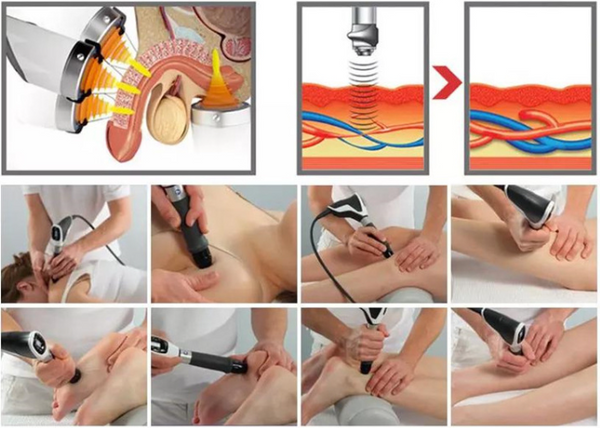Shockwave therapy is becoming increasingly popular in the beauty industry, as it is a non-invasive treatment that has been shown to improve the success rate of many #aesthetictreatments and procedures. If you're a brand owner, distributor, salon/#clinic owner or spa/salon professional looking for an effective way to reduce signs of aging or treat certain health conditions without resorting to surgery, then shockwave therapy could be your answer. In this blog post, we'll look at what shockwave therapy is, its benefits and potential risks and how successful the technology can be when it comes to providing positive outcomes for patients. Let's dive in!
Overview of Shockwave Therapy
#Shockwave therapy is a non-invasive and highly effective treatment used to alleviat e pain and promote healing in numerous conditions. This innovative approach uses sound waves to stimulate the healing process and improve blood flow to the affected area. Shockwave therapy has been shown to be effective in treating conditions such as plantar fasciitis , tennis elbow , and rotator cuff tendinopathy, among others. The treatment is quick, typically lasting around 30 minutes, and requires no anesthesia. While there may be some mild discomfort during the procedure, side effects are generally minimal, making it a safe and practical option for patients seeking pain relief and improved mobility. If you're experiencing persistent pain and other treatments have failed, it may be worth considering shockwave therapy as an effective and efficient solution.

History and Benefits of Shockwave Therapy
#Shockwavetherapy is a revolutionary form of treatment that is rapidly gaining popularity across the globe. It involves the use of high-frequency sound waves to stimulate healing in injured tissues. Shockwave therapy has been around for decades, but only recently have experts put it to good use in the medical field.The process has proven to be effective in treating a wide variety of ailments, including chronic pain, inflammation, and even bone fractures. Shockwave therapy works by encouraging the body's natural healing processes, resulting in faster recovery times and fewer complications. What makes this treatment so unique is that it is completely non-invasive, meaning that patients can enjoy all the benefits of treatment without the need for surgery or medication. If you're in search of a safe and effective form of treatment, shockwave therapy may be just what you need.

What is the Success Rate of Shockwave Therapy for Different Ailments/Conditions
When it comes to treating various health ailments and conditions, shockwave therapy has been gaining popularity in recent years. This non-invasive treatment uses high-frequency sound waves to stimulate the body’s natural healing process. But what is the success rate of shockwave therapy for different conditions? Research suggests that shockwave therapy has been effective in treating conditions such as plantar fasciitis, Achilles tendonitis , and tennis elbow, with success rates ranging from 60-80%. However, results may vary depending on the individual and the severity of their condition. Despite this, shockwave therapy remains a promising option for those seeking a non-surgical solution to their pain management.

How Does Shockwave Therapy Work
There's been a lot of buzz lately about shockwave therapy as a treatment option for various musculoskeletal conditions. But how exactly does it work? Shockwave therapy involves using high-pressure sound waves to stimulate the body's natural healing response. These sound waves are directed to specific areas of the body that are experiencing pain or discomfort, where they penetrate deep into the tissue. This helps to increase blood flow, promote tissue regeneration, and reduce inflammation. While the idea of using sound waves to heal may seem a bit unconventional, the science behind it is fascinating and promising. As more research is done, we may begin to see shockwave therapy become a more commonly used treatment option for a variety of conditions ranging from plantar fasciitis to tennis elbow.
Types of Shockwaves Used in Therapy
In recent years, shockwave therapy has become a popular tool in the world of #physicaltherapy and rehabilitation. Shockwaves, or high-energy soundwaves, are a non-invasive way to treat various musculoskeletal disorders and injuries. There are three main types of shockwaves used in therapy: radial shockwaves, focused shockwaves, and planar shockwaves. Radial shockwaves are used to treat surface-level injuries, while focused shockwaves are directed towards deeper tissues and are used in treating more complex injuries. Planar shockwaves are a hybrid of the two, using both radial and focused waves to treat deep tissue and surface-level injuries simultaneously. Learning about the different types of shockwaves can help patients better understand which type of therapy will work best for their specific needs.
Risks and Side Effects Associated with Shockwave Therapy
Shockwave therapy has gained popularity over the years as a non-invasive treatment for a variety of musculoskeletal conditions. While it can be effective in reducing pain and promoting healing, there are risks and side effects associated with the treatment. Some patients may experience mild discomfort during the procedure, while others may develop bruises or skin irritation at the site of treatment. In rare cases, more serious complications such as blood vessel damage or nerve injury may occur. It is important to discuss the potential risks and benefits of shockwave therapy with your #healthcare provider before proceeding with treatment.
In conclusion, shockwave therapy could be a viable option for a wide range of medical conditions, such as Achilles tendon tears, plantar fasciitis and chronic shoulder pain. This treatment offers the potential for patients to reduce their current pain with relatively minimal side effects. For some conditions, shockwave therapy can offer higher success rates than other traditional treatments like steroid injections or surgery. However, it is important to point out that each patient's situation is different and that there may be significant complications associated with this procedure depending on the severity of the condition. Ultimately, consultation of a qualified health professional will be needed in order to determine if this is an appropriate course of action.
To learn more about this machine, please feel free to contact us!

